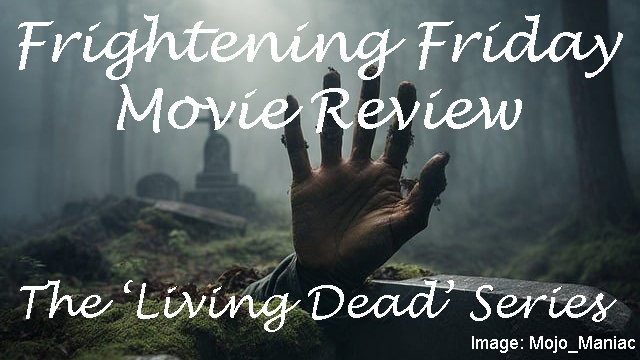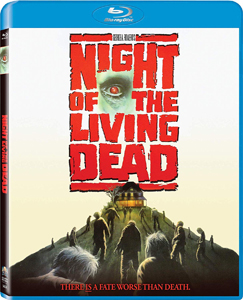The “Living Dead” series is unusual in that the first three George Romero films got remade even while Romero himself was still doing the primary saga. And in fact Romero himself wrote a slightly altered screenplay for the first remake, 1990’s “Night of the Living Dead.”
It started a tradition of the films being remade a little over two decades after the original:
- “Night of the Living Dead” (1968 original, 1990 remake; 22 years)
- “Dawn of the Dead” (1978 original, 2004 remake; 26 years)
- “Day of the Dead” (1985 original, 2008 remake; 23 years)
Although the 1968 film is a classic that invented the modern Slow Zombie and the attendant rules about killing it by destroying the brain, director Tom Savini proves it was worth remaking. He gives a tighter, respectful retelling with better makeup effects (headed by John Vulich, later of “Buffy”). Romero adds touches late in the screenplay that tip us off to the themes he’d explore in his 21st century “Dead” films.

“Night of the Living Dead” (1990)
Director: Tom Savini
Writers: George A. Romero (screenplay and original screenplay), John A. Russo (original screenplay)
Stars: Tony Todd, Patricia Tallman, Tom Towles
Ben vs. Cooper
Again, the emphasis is on Ben, who is “the boss up here” in the farmhouse, and Cooper, who is “the boss down there” in the cellar. Without major alterations to the script, the metaphor for society becomes sharper (or perhaps it’s because it’s my second time watching this story in a short timeframe). Either you’re a Ben, looking for intelligent solutions to problems, or you’re a Cooper, criticizing others while hiding yourself away.
Playing Ben is a pre-fame Tony Todd, who would go on to have the career original Ben actor Duane Jones perhaps should have. In a remarkable coincidence, he’s introduced with a shot of the hooked crowbar he’s carrying. This was two years before Todd would play the iconic hook-handed Candyman.
Tom Towles is also good in the thankless role of Cooper, who is so obviously in the wrong I almost expected a new arc of him realizing he should help out more.
Not so meek anymore
Romero saves his reinvention for Barbara (Patricia Tallman) – gaining an “a” in the middle of her name — who undergoes a swift but plausible (considering Ben’s knack for urging her on) transition from scaredy-cat to Sarah Connor-type shotgun-wielding heroine.
Fans of “Wonderfalls” will enjoy seeing a young Katie Finneran as farm gal Judy Rose. She likewise gets punched up from the original, as meekness in survival situations is not divided by gender lines in this remake.
A lot of the pleasure of watching “Living Dead” 1990 comes from seeing how Romero alters his own material, and how Savini (who worked on special effects in the first two sequels) subtly increases the threat level through pacing, framing, lighting and mood music. Thus we learn what they saw as weaknesses in the intervening 22 years.
The most interesting talking points come at the end, and – perhaps because there were enough alterations already – I was excited to see what the final twists would be.
(SPOILERS FOLLOW.)
A few new surprises (Spoilers)
The 1968 film has a famously bleak ending wherein Ben does everything right to survive the farmhouse incursion, but then he’s killed by the sloppy militia clean-up crew. In the 1990 version, Ben has turned into a zombie (thanks to the reckless Cooper shooting him) and Cooper has survived.
Barbara shoots Cooper, knowing he’s human, and announces to the clean-up crew “Here’s another one for the fire.” Satisfying stuff in movie form, for sure. But not something I’d advocate if it were reality. Barbara might be speaking for herself when she observes that “They are us, and we are them” when the redneck militiamen use zombies for target practice rather than finishing them off.
The epilog sequence hints at what was going through Romero’s mind at a time when he hadn’t yet decided to do a fourth “Dead” film. In 2005’s “Land of the Dead,” he’d robustly show the slum residents of the walled city using zombies for sport in shooting and cage-fight games.
And in his reboot duology (2007’s “Diary of the Dead” and 2009’s “Survival of the Dead”), he’d further emphasize the ickiness of humans using zombies for play, rather than putting them out of their misery. Ironically, a lot of the (sometimes well-meaning) villains or scientists in the “Dead” films believe zombies can be rehabilitated, which is absurd on the face of it.
But while those people are likely wrong, Romero still believes that how we treat others (even the undead) says everything about our own individual natures. We see an early hint in the 1990 “Night of the Living Dead” that – while the question of humanity’s physical survival is up in the air – he does not have high hopes for humanity’s moral survival.


